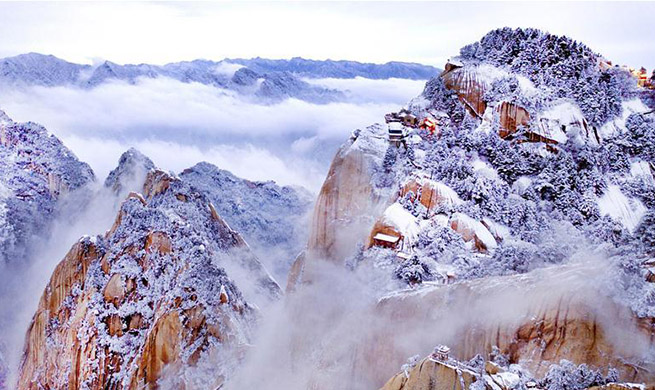URUMQI, Jan. 28 (Xinhua) -- For a group of scientists, the winter season does not bring exciting prospects of skiing or riding snowmobiles. It is a season where they spend weeks tracking over snow-covered wilderness.
A team of nine researchers from the Xinjiang Institute of Ecology and Geography under the Chinese Academy of Sciences (CAS) have completed a 12-day field study on snow in the Tianshan Mountains in Xinjiang Uygur Autonomous Region, which hold a vast variety of snow-capped peaks, glaciers, alpine meadows, canyons and lakes.
The researchers began collecting data on Jan. 14 on the depth, distribution and surface characteristics of snow in the Tianshan Mountains.
They need to make three such field trips around Tianshan during the snow season from the latter half of 2018 to early 2019. Each trip takes over 12 days.
"Snow is an indicator of global climate change and also an important source for water resources. Understanding snow is vital to studying water resources in the area, predicting a trend, evaluating climate change and giving warnings of disasters such as avalanches," said Li Lanhai, a researcher in the team.
The Xinjiang institute has 11 field stations to measure the snow-covered area. Hiking through the no-man region in Tianshan can be an excruciating experience for researchers.
During this field trip, researchers had to work in an environment where the temperature dipped to minus 38.4 Celsius degrees.
Nationwide, six teams, including the one in Xinjiang, are studying snow cover in the northeast part of China and the Qinghai-Tibet Plateau. These researchers come from the Northwest Institute of Eco-Environment and Resources of CAS, Nanjing University and Northwest University.
The aim is to build a national database for snow cover in China, researchers said.
"Though the snow is short-lived, it is the lifeblood of water resources in Xinjiang," said Li Lanhai.
Researchers need to process the data to provide early warnings and improve risk management in the regions that have frequent avalanches and snow-related floods, he said.
Li's team analyzed the data on snow from 1901 to 2014 and observational data from 1961 to 2014 in the Tianshan Mountains.
The snow depth in the Tianshan region shows a downward trend in 1901-2014, with variation in different spatial and temporal scales, according to their study published in the journal Global and Planetary Change this year.

















